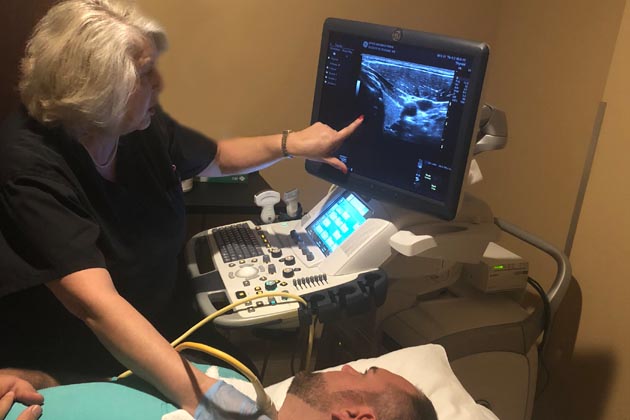Ultrasonido
¿Qué es el ultrasonido?
El ultrasonido de diagnóstico es una técnica de imagen que utiliza ondas de sonido de
alta frecuencia generadas por un dispositivo de mano llamado transductor. El
transductor es colocado en la piel donde ecos creados por ondas sonoras producen
imágenes de los órganos internos. El ultrasonido no implica radiación, que es una de
las razones por las que se usa habitualmente para examinar fetos en el útero. Hay
muchas aplicaciones para la ecografía (ultrasonido), tales como la evaluación de los
órganos abdominales y pélvicos, evaluación de vasos sanguíneos en busca de
coágulos o placa aterosclerótica, examinar las estructuras superficiales del cuello y las
extremidades, y proporcionar orientación para las biopsias o para drenar las
colecciones de líquidos.

Nuestro equipo tiene aplicaciones en los siguientes escáneres de imágenes:
- Abdomen/Pelvis
- Obstetricia / ginecología incluyendo histerosonografía
- Vascular periférico incluyendo dopplers arteriales y venosos
- Vascular incluyendo estudios de carótida
- Tiroides
- Testicular
- Renal
Extremidades superiores / inferiores - Ultrasonido OB en 3D y 4D en tiempo real
- Hígado incluyendo elastografía de onda cortante
Cómo prepararse para el examen…
Ultrasonido Abdominal – Nada de comer o beber durante 6 horas antes del examen.
Ultrasonido Pélvico (transabdominal) – Comience a beber 32 onzas de agua una hora y media antes de su examen. Termine el agua una hora antes de su examen. No vacíe su vejiga hasta que se complete el estudio.
Ultrasonido Renal – Comience a beber 20 onzas de agua una hora y media antes de su cita. Termine el agua una hora antes de su examen. No vacíe su vejiga hasta que se complete el estudio.
Ultrasonido Obstétrico– Comience a beber 32 onzas de agua una hora y media antes de su examen. Termine el agua una hora antes de su examen. No vacíe su vejiga hasta que se complete el estudio. Se aplica una pequeña cantidad de gel soluble en agua sobre la piel sobre el área a examinar por lo que se le puede pedir que se quite algo o toda su ropa y use una bata, pantalones o camisa uniforme médico durante el examen.
